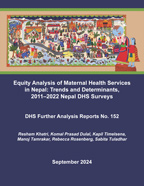There is no printed copy available to order.
Abstract:
Over the past three decades, Nepal has made
significant progress in improving access to
and use of maternal health services and in
reducing maternal morbidities and
mortalities. However, the pace has been slow,
the maternal mortality ratio is still high,
and some disadvantaged groups still have
disproportionately high rates of maternal
morbidity and mortality. These groups might
either have poor access to maternal health
services or be receiving suboptimal quality
of care. Thus, this study aimed to
investigate trends in and determinants of use
of key maternal health services, considering
selected socioeconomic and demographic
factors in Nepal.
We conducted trend analyses of maternal
health services using data from the 2011
Nepal Demographic and Health Survey (NDHS) (n
= 1,057), the 2016 NDHS (n = 964), and the
2022 NDHS (n = 981) among women age 15–49 who
had at least one live birth in the 1 year
prior to each survey. Outcome variables were
at least four antenatal care visits,
institutional delivery, postnatal care, and
completion of all maternal care visits. We
also identified the determinants of use of
these services by analyzing data from the
2022 NDHS (n = 981). Outcome variables were
institutional delivery, place of
institutional delivery, delivery by cesarean
section, and uptake of maternity incentives.
Independent variables included selected
background characteristics and the
marginalization status of women.
Marginalization status was an intersectional
variable that incorporated wealth status,
ethnicity, and education to identify multiple
forms of disadvantage.
Analyses revealed low completion and high
discontinuation of services along the
maternity care continuum and increasing
trends in institutional delivery and delivery
by cesarean section in private health
facilities (HFs). Institutional delivery was
high among women who had at least four
antenatal care visits and low among women
from Karnali province, those with multiple
disadvantages (women in the lower wealth
quintiles who had no education and were from
disadvantaged ethnic groups), Maithili and
Bhojpuri native speakers, and women with a
high birth order. Similarly, delivery in
private HFs was most common in Koshi,
Bagmati, Madhesh, and Lumbini provinces and
among women with single or no disadvantages.
Delivery in private HFs was less likely among
women working in manual labor or those with a
high birth order. Delivery by cesarean
section was most common among pregnant women
of older ages, Maithili native speakers, and
women in provinces with high rates of
delivery in private HFs. Low rates and a
decreasing trend were found for uptake of
maternity incentives in private HFs and in
Koshi, Bagmati, Madhesh, and Lumbini
provinces.
Overall, women from the most disadvantaged
groups had lower uptake of routine maternity
care visits, higher rates of discontinuation
of antenatal through postnatal care, and
wider equity gaps than more advantaged
groups. Increasing trends in delivery in
private HFs and delivery by cesarean section,
coupled with limited or no maternity
incentives, could lead to financial burdens
for those already left behind. Health systems
need to focus on designing and implementing
targeted and contextual strategies and
approaches in Madhesh and Karnali provinces
and among women with multiple disadvantages.
 Equity Analysis of Maternal Health Services in Nepal: Trends and Determinants, 2011–2022 Nepal DHS Surveys (PDF, 3680K)
Equity Analysis of Maternal Health Services in Nepal: Trends and Determinants, 2011–2022 Nepal DHS Surveys (PDF, 3680K)
